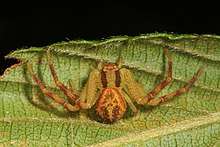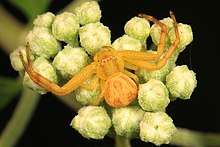Mecaphesa asperata
| Mecaphesa asperata | |
|---|---|
 | |
| Scientific classification | |
| Kingdom: | Animalia |
| Phylum: | Arthropoda |
| Subphylum: | Chelicerata |
| Class: | Arachnida |
| Order: | Araneae |
| Infraorder: | Araneomorphae |
| Family: | Thomisidae |
| Genus: | Mecaphesa |
| Species: | M. asperata |
| Binomial name | |
| Mecaphesa asperata (Hentz, 1847) | |
| Synonyms[1] | |
| |
Mecaphesa asperata, the northern crab spider, is a species of crab spider in the family Thomisidae, found in North and Central America, and the Caribbean.[1] It is a species of the 'flower spiders', so-called because they generally hunt in similarly coloured flowers for visitors such as bees and flies, and is a much smaller nearctic relative of the better-known Goldenrod Spider (Misumena vatia).[2][3][4][5]
Mecaphesa asperata was formerly in the genus Misumenops under the name Misumenops asperatus.[6][1]
Howell (2004) provides the following diagnosic/identifying characteristics: "M. asperatus is distinguished from Misumenoides and Misumena in that the carapace, abdomen and legs are distinctively covered with numerous short stiff spines. The ocular region is white. On the anterior half, the abdomen has red streaks laterally. On the posterior half, the abdomen has a mottled brown to red-brown V-shaped mark pointed towards the posterior. All legs are yellow, except the tibia and metatarsus I bear red annuli."[7]


References
- 1 2 3 "NMBE World Spider Catalog, Mecaphesa asperata". Retrieved 2018-05-06.
- ↑ "Mecaphesa asperata Report". Integrated Taxonomic Information System. Retrieved 2018-05-06.
- ↑ "Mecaphesa asperata species details". Catalogue of Life. Retrieved 2018-05-06.
- ↑ "Mecaphesa asperata". GBIF. Retrieved 2018-05-06.
- ↑ "Mecaphesa asperata Species Information". BugGuide.net. Retrieved 2018-05-06.
- ↑ Lehtinen, P. T.; Marusik, Y. M. (2008). "A redefinition of Misumenops F. O. Pickard-Cambridge, 1900 (Araneae, Thomisidae) and review of the New World species". Bulletin of the British Arachnological Society. 14: 173–198.
- ↑ Howell, W. Mike (2004). Spiders of the Eastern United States. Boston: Pearson Education Inc. ISBN 0-536-75853-0.
Further reading
- Adams, Richard J.; Manolis, Timothy D. (2014). Field Guide to the Spiders of California and the Pacific Coast States (California Natural History Guides). University of California Press. ISBN 978-0520276611.
- Bradley, Richard A. (2012). Common Spiders of North America. University of California Press. ISBN 978-0520274884.
- Foelix, Rainer F. (2010). Biology of Spiders (3rd ed.). Oxford University Press. ISBN 978-0199734825.
- Jackman, John A. (2002). A Field Guide to Spiders and Scorpions of Texas. Gulf Publishing. ISBN 978-0877192640.
- Milne, Lorus; Milne, Margery (1980). National Audubon Society Field Guide to Insects and Spiders. Knopf.
- Ubick, D.; Paquin, P.; Cushing, P.E.; Roth, V., eds. (2005). Spiders of North America: An Identification Manual. American Arachnological Society. ISBN 978-0977143900.
- Wheeler, W.C.; Coddington, J.A.; Crowley, L.M.; Dimitrov, D.; et al. (2016). "The spider tree of life: phylogeny of Araneae based on target-gene analyses from an extensive taxon sampling". Cladistics. 33 (6): 576–616. doi:10.1111/cla.12182.
External links
